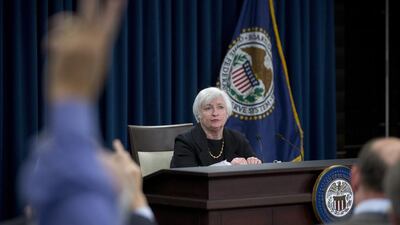Although the markets were technically not pricing in much chance of a rise in US interest last week (about 28 per cent by most measures), there was still a great deal of surprise and no small amount of confusion when the Federal Open Market Committee’s unchanged decision was announced on Thursday evening.
This was because the analyst community was split more or less 50-50 over the outcome, and in the past few days before the decision the momentum appeared to be with those looking for a hike, if only for the Fed to get the first interest rate rise behind it.
The Fed blinked at the opportunity to tighten monetary policy for the first time in nine years, even though many in the markets would have understood its reasons if it had only raised interest rates by 0.25 per cent or even less. As it is, the window of opportunity for it to act this year has now got smaller, leaving the Fed dangerously exposed and boxed in should events turn even more difficult through the final quarter, with few tools left that it could use to respond to any external shocks.
The crux of the Fed’s decision to stay put appears to come down to the new sentence that appeared in the statement, saying: “recent global economic and financial developments may restrain economic activity somewhat and are likely to put further downward pressure on inflation in the near term”.
Despite the improvement of domestic fundamentals, the Fed is now more concerned about the slowing global economy – by which it means developments in China and other emerging markets – along with the downturn in commodity prices and perhaps the strength of the dollar. These were the issues that tipped the balance in favour of waiting for more information about the labour market and probably about prices.
However, the Fed chairwoman Janet Yellen was short on specifics about what might actually cause the Fed to tighten policy. Forecasts for Nairu (the non-accelerating inflation rate of unemployment) were lowered again, despite the unemployment rate having reached the level the Fed had previously anticipated was full employment (5.1 per cent) last month.
GDP growth estimates were raised for this year but lowered thereafter, and the dot-plot Fed funds rate estimates were lowered slightly, to imply only one interest rate rise by the end of the year and a lower long-term equilibrium level of 3.5 per cent (which is still too high by most estimates).
Furthermore, Ms Yellen’s commentary is forever changing and appearing increasingly random and sometimes contradictory. Whereas in July Ms Yellen had said that the US economy “cannot only tolerate but needs higher rates”, this time she even said there is rationale for a rate hike now, while offsetting this by saying the situation abroad had become “more uncertain of late”.
At the same time, however, she does not want to overplay the impact of overseas developments, and appeared at one point to downplay the impact of the strong dollar by emphasising the bigger importance of the consumer to the US economy. Although disinflation imported from abroad has moved the Fed further away from its inflation mandate, Ms Yellen stuck to her previous line that this was likely to be transitory.
Finally, the decision to raise interest rates will not depend on any single piece of data, and options were left well and truly open when it comes to upcoming FOMC meetings, with all of them considered to be live ones. That keeps next month a possibility for a tightening. More worryingly perhaps, when asked about the possibility of more quantitative easing, she merely observed that it was not being discussed, but was possible in the future.
Given this assessment, it is easy to see why many in the market do not believe the Fed will ever get around to raising interest rates, let alone before the end of this year. The consensus is probably rightly coalescing around a December move still, but the uncertainty Ms Yellen delivered will not make things any easier. Her confused message is likely to lead to even greater volatility in financial markets, which could potentially make it even harder for the Fed to pull the trigger, leaving it with few remaining options if the recovery runs out of steam.
Tim Fox is the head of research and chief economist at Emirates NBD.
Follow The National's Business section on Twitter


